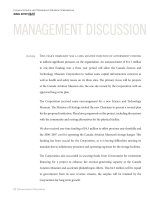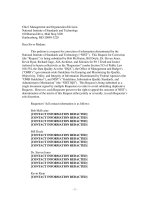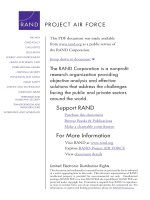Clothing appearance and fit Science and technology
Bạn đang xem bản rút gọn của tài liệu. Xem và tải ngay bản đầy đủ của tài liệu tại đây (5.93 MB, 260 trang )
Clothing appearance and fit:
Science and technology
Clothing
appearance and fit:
Science and
technology
J. Fan, W. Yu and L. Hunter
Published by Woodhead Publishing Limited in association with The Textile Institute
Woodhead Publishing Limited
Abington Hall, Abington
Cambridge CB1 6AH
England
www.woodhead-publishing.com
Published in North America by CRC Press LLC
2000 Corporate Blvd, NW
Boca Raton FL 33431
USA
First published 2004, Woodhead Publishing Limited and CRC Press LLC
ß 2004, Woodhead Publishing Limited
The authors have asserted their moral rights.
Every effort has been made to trace and acknowledge ownership of copyright. The publishers will
be glad to hear from the copyright holders whom it has not been possible to contact concerning:
Figures 1.2, 3.4, 6.1, 6.3, 6.5, 6.6, 7.3, 7.9, 8.26, 8.27, 10.4 and 10.7; Tables 6.3, 6.4, 6.5, 6.7,
6.12, 6.13 and 6.14.
This book contains information obtained from authentic and highly regarded sources. Reprinted
material is quoted with permission, and sources are indicated. Reasonable efforts have been made
to publish reliable data and information, but the authors and the publishers cannot assume
responsibility for the validity of all materials. Neither the authors nor the publishers, nor anyone
else associated with this publication, shall be liable for any loss, damage or liability directly or
indirectly caused or alleged to be caused by this book.
Neither this book nor any part may be reproduced or transmitted in any form or by any means,
electronic or mechanical, including photocopying, microfilming and recording, or by any
information storage or retrieval system, without permission in writing from the publishers.
The consent of Woodhead Publishing Limited and CRC Press LLC does not extend to copying
for general distribution, for promotion, for creating new works, or for resale. Specific permission
must be obtained in writing from Woodhead Publishing Limited or CRC Press LLC for such
copying.
Trademark notice: Product or corporate names may be trademarks or registered trademarks, and
are used only for identification and explanation, without intent to infringe.
British Library Cataloguing in Publication Data
A catalogue record for this book is available from the British Library.
Library of Congress Cataloging-in-Publication Data
A catalog record for this book is available from the Library of Congress
Woodhead Publishing Limited ISBN 1 85573 745 0
CRC Press ISBN 0-8493-2594-3
CRC Press order number: WP2594
The publisher's policy is to use permanent paper from mills that operate a sustainable forestry
policy, and which have been manufactured from pulp which is processed using acid-free and
elementary chlorine-free practices. Furthermore, the publisher ensures that the text paper and
cover board used have met acceptable environmental accreditation standards.
Project managed by Macfarlane Production Services, Markyate, Hertfordshire ()
Typeset by MHL Typesetting Limited, Coventry, Warwickshire
Printed by TJ International Limited, Padstow, Cornwall, England
List of figures ix
List of tables xv
Preface xvii
Acknowledgements xix
1Perception of body appearance and its relation to clothing 1
JFAN
1.1 Introduction 1
1.2 Beauty 1
1.3 Facial attractiveness 3
1.4 Body physical attractiveness 4
1.5 Body image 8
1.6 Modification of body appearance by dressing 9
1.7 References 13
2Subjectiveassessment of clothing appearance 15
JFAN
2.1 Introduction 15
2.2 Assessment of fabric surface smoothness 15
2.3 Assessment of seam appearance 20
2.4 Assessment of crease retention 24
2.5 Assessment of appearance retention of finished garments 25
2.6 Reliability of subjective assessment 27
2.7 References 29
3Subjectiveassessment of clothing fit 31
WYU
3.1 Definition of fit 31
3.2 Influences on clothing fit 32
Contents
3.3 Testing methods for dimensional fit 33
3.4 Subject rating scales 37
3.5 Subjective fitting guide 38
3.6 Conclusions 41
3.7 References 41
4Objective evaluation of clothing appearance 43
JFAN, L HUNTER AND F LIU
4.1 Introduction 43
4.2 Objective evaluation of fabric wrinkling 43
4.3 Objective evaluation of fabric pilling 54
4.4 Objective evaluation of seam pucker 60
4.5 Objective evaluation of overall garment appearance 66
4.6 References 68
5Objective evaluation of clothing fit 72
WYU
5.1 Introduction 72
5.2 Moire optics 72
5.3 Algebraic evaluation of clothing fit 78
5.4 Clothing waveform 80
5.5 Pressure evaluation of clothing fit 84
5.6 3D modelling of pressure fit 86
5.7 Conclusions 86
5.8 References 87
6 Fabric properties related to clothing appearance and fit 89
L HUNTER AND J FAN
6.1 Introduction 89
6.2 Reviews 92
6.3 Fabric objective measurement (FOM) 92
6.4 References 111
7Garment drape 114
L HUNTER AND J FAN
7.1 Introduction 114
7.2 Reviews on drape 114
7.3 The measurement of fabric drape 115
7.4 Empirical prediction of static drape 117
7.5 Dynamic fabric drape 122
7.6 Seamed fabric drape 122
vi Contents
7.7 Modelling fabric and garment drape 123
7.8 Drape models in commercial CAD and Internet systems 125
7.9 Concluding remarks 130
7.10 References 131
83-Dbodyscanning 135
WYU
8.1 Introduction 135
8.2 Global development of body scanners 136
8.3 Principles and operations of body scanning technologies 145
8.4 Benchmarking 161
8.5 Challenges of 3D body scanning 164
8.6 Concluding remarks 166
8.7 References 167
9Human anthropometrics and sizing systems 169
WYU
9.1 Terms and definitions 169
9.2 Traditional anthropometry 171
9.3 Historical development of sizing system 174
9.4 Latest national size survey using 3-D body scanner 177
9.5 International sizing 182
9.6 Principles of sizing systems 184
9.7 Conclusion 190
9.8 References 193
10 Garment design for individual fit 196
MYKWONG
10.1 Introduction 196
10.2 Pattern alteration for fit 196
10.3 Prediction of garment patterns from body measurements 203
10.4 Three-dimensional (3-D) apparel design systems for pattern 207
generation and garment fit
10.5 Virtual fitting on the Internet 226
10.6 References 229
Index 234
Contents vii
1.1 Golden ration in nature, design and architecture. 2
1.2 Beautiful faces fitted with beauty masks. 4
1.3 Ideal Greek proportions of female figure. 5
1.4 Ideal Greek proportions of male figure. 6
1.5 Female body figures having varying WHR. 7
1.6 (a) Plot of log(VHI) versus log(AR) by male viewers; (b) plot
of log(VHI) versus log(AR) by female viewers.
8
1.7 Nine-figural scale of Thompson and Gray, 1995. 10
1.8 Interaction between viewer, clothing, body and environment. 10
1.9 Effect of design on the perception of body proportion. 12
1.10 The perceived body size grades of the thin model, medium
model and obese model.
12
2.1 Lighting equipment for viewing test specimens. 16
2.2 View device for pilling assessment. 17
2.3 ICI Pilling Box Tester. 18
2.4 Martindale Tester. 18
2.5 Random Tumble Pilling Tester. 19
2.6 Photographic Comparative Ratings for Single and Double
Needle Seams.
21
2.7 Viewing Apparatus for Garments. 23
2.8 Grade scale of yoke position. 24
2.9 Grade scale of armhole position. 24
2.10 Grade scale of buttonhole placket position. 24
2.11 Grade scale of button placket position. 25
2.12 Grade scale of pocket position. 25
2.13 Rating Scale for the Appearance of Wool Suits. 26
3.1 Criteria for qualitative evaluation of clothing fit. 32
3.2 Difference between the (a) new and (b) conventional dress
form.
36
Figures
3.3 Digital human body model based on anatomical landmarks. 36
3.4 Taninaka's Dress stand. 37
3.5 Wearer acceptability scale. 38
3.6 Fit evaluation scale. 39
4.1 SAWTRI Wrinklemeter. 44
4.2 (a) The measuring system using laser triangulation; (b) The
laser scanner from CyberScan.
56
4.3 Schematic set-up of the image-analysis system. 59
4.4 The 3-D Model Maker laser scanner. 64
4.5 (a) Subjective Grade vs Log(
2
) for Yoke seam; (b) Subjective
Grade vs Log(
2
) for Pocket seam; (c) Subjective Grade vs
Log(
2
) for Placket seam; (d) Subjective Grade vs Log(
2
) for
Armhole seam.
66
4.6 Objective evaluation of overall garment appearance. 68
5.1 Moire measurements of the human body. 73
5.2 Schematic setup of the moire system. 74
5.3 Moire image of bra cup. 75
5.4 Moire system for jacket measurement. 75
5.5 Moire image of jacket. 76
5.6 Sectional analysis of clothing fit. 76
5.7 Polynomial curves of centre back profile. 77
5.8 Maternity support. 78
5.9 Outer suit. 78
5.10 Example of a Signature Curve on the bodice. 80
5.11 Cross-sectional profile of body and clothing at the waist line;
body shape, clothing shape, calculated clothing shape.
81
5.12 Cross-sectional shape of clothing at the waistline and its
derived waveform.
82
5.13 Clothing waveform of different sizes: 9, 11 and 13. 82
5.14 Cross-sectional waveforms of various clothing materials at (a)
the hip level, (b) the waist level and (c) the bust levels for a
body size no. 9.
83
5.15 Magnitude of the wavelet transform at the bust line waveform
of a body size no.9: (a) cross-sectional clothing shape, (b)
amplitude of waveform, (c) magnitude of the wavelet
transform.
83
5.16 Manufacture of soft mannequin. 84
6.1 Process used by experts in the subjective evaluation of fabric
handle.
90
6.2 A history of the textile technology of the twentieth century. 92
xFigures
6.3 System for the objective evaluation of fabric handle. 95
6.4 The KES-F system for measuring fabric mechanical properties. 98
6.5 Principles used in the KES-F instruments for the objective
measurement of fabric mechanical and surface properties.
99
6.6 Typical deformation-recovery curves for (a) fabric extension
or lateral compression, and (b) fabric bending or shear,
showing the energy loss during a complete cycle as the
shaded area.
100
6.7 Relation between the three primary hands and the mechanical
properties.
101
6.8 Basis of objective evaluation of KES-FB system. 102
6.9 High TAV zone for suit expressed by the three components. 104
6.10 `Tailoring Control Chart' and high quality zone from wear
comfort.
104
6.11 The FAST control chart for light-weight suiting fabrics. 110
7.1 Cusick's Drapemeter. 116
7.2 Drape image. 116
7.3 Some factors contributing to fabric drape behaviour. 117
7.4 An image analysis system for measuring static and dynamic
drape behaviour of fabrics.
118
7.5 Particle-based model. 125
7.6 Visualisation of garment in 3D. 127
7.7 Computer screen of Maya Cloth
TM
.128
7.8 Cloth simulation in Syflex. 129
7.9 Virtual draping of clothing in My Virtual Model
TM
.130
8.1 Horizontal sliding gauge and vertical sliding gauge. 136
8.2 (a) Algin Method and (b) Gypsum Method. 137
8.3 Silhouette analyser. 138
8.4 Fujinon Moire Camera in 1980s. 139
8.5 Output of Conusette's scan. 139
8.6 Digital output from Voxelan laser scanner. 140
8.7 Cubic's hardware structure. 140
8.8 Close look at CubiCam. 141
8.9 CubiCam's optical design. 142
8.10 SYMCAD OptiFit. 145
8.11 Schemetic set up of 2D photographic methods. 146
8.12 Schemetic set up of LASS system. 147
8.13 Figure of moire image of human body. 149
8.14 RSI DigiScan 2000. 151
8.15 Figure of TC
2
PMP theory. 152
8.16 TriForm 3D Body Scanner. 153
Figures xi
8.17 3D Scanner's ModelMaker. 154
8.18 Cyberware WB4 Scanner. 155
8.19 Vitus body scanner. 156
8.20 Voxelan's HEV-1800HSW scanner. 157
8.21 FastScan scanner. 158
8.22 IR Sensor. 158
8.23 LED with PSD system. 159
8.24 Stereo picture. 160
8.25 Schematic diagram of stereoscopy. 160
8.26 Cubic Compact Model and Entire Body Model. 162
9.1 Critical anatomical points. 170
9.2 Key body landmarks. 171
9.3 Definition of vertical body measurements. 172
9.4 The year of birth versus the average stature of Japanese people
aged 20.
179
9.5 Three measuring postures. 179
9.6 Distribution of figure types in ISO (1991). 187
10.1 Cross sectional view of the geometric model for the
experimental pattern.
204
10.2 Computer pattern draft of experimental pattern. 204
10.3 Locations of photographic measurements. 205
10.4 Design of blouse superimposed onto photographs of the human
body.
208
10.5 Location of the crucial shaping points. 209
10.6 Division of the body into triangular sections. 210
10.7 The mapping of the garment at the bust level. 211
10.8 Diagram of two vertical cross sections of the body and a `last'
for a basic skirt.
212
10.9 Diagram of a `last' for a basic skirt. 213
10.10 The selection of base sections and an example of a different
growth ratio for the bust section.
214
10.11 The generic feature model of a mannequin with detailed
features listed.
216
10.12 The generation of the bodice dummy; (a) a pair of images
captured by two cameras; (b) reconstructed mesh structure and
shaded surface for right front panel; (c) assembled bodice
model with four panels.
217
10.13 The overview of the 3D garment design system operations. 220
10.14 Garment piece with a superimposed equimesh grid. 222
10.15 Multistrand garment-piece pattern. 223
10.16 The Overlaps eliminated by the spreading out of strands. 223
xi i Fi gures
10.17 The integration of the design interface, the pattern flattening
and the fabric drape engine, a) stylished 3D garment panel
design with dart, b) garment panel triangulation with dart,
c) 2D flattening of panel with dart, d) 3D drape of panel
with texture rendering.
224
Figures xiii
2.1 Rating standard based on standard three-dimensional replicas 23
2.2 Rating standard based on photographic standards 23
3.1 Advantages and disadvantages of fitting standards 34
3.2 Exercise protocol 34
6.1 Assessment of fabric performance in apparel 89
6.2 Fabric properties that are related to tailoring performance,
appearance in wear, and handle
91
6.3 Basic fabric mechanical properties and related quality and
performance attributes of fabrics and garments
94
6.4 Application of fabric objective measurement technology 94
6.5 The sixteen parameters describing fabric mechanical and
surface properties
100
6.6 Primary hands 101
6.7 Influence of measured parameters on PHV 102
6.8 The desirable range of mechanical properties for high-quality
suit production
103
6.9 The range of mechanical properties for fabric to be rejected 103
6.10 Interrelation between difficulties in sewing process and ranges
of mechanical parameters
103
6.11 The criteria for ideal fabric 105
6.12 Summary of CSIRO's FAST system 108
6.13 Fabric properties associated with problems in garment making 109
6.14 Fabric properties associated with potential poor garment
appearance in wear
109
7.1 Drape coefficients (%) 119
8.1 Major 3D scanner manufacturers 162
8.2 Comparison between different body scanners 163
Tables
9.1 Examples of latest size designations in various countries 182
9.2 German men's figure type categorisation 187
9.3 American sizing system 188
9.4 Classification of the French tables according to types 188
9.5 Japanese garment types and key dimensions 189
9.6 Size labelling and body measurements in various countries 190
9.7 Comparison of size interval and drop value of men in different
countries
191
xvi Tables
Decoration, modesty and protection are the three most fundamental reasons for
people to wear clothing. Two of these, decoration and modesty, are directly
influenced by the appearance and fit of the clothing. The question which arises is
how clothing should be designed, manufactured and dressed so as to provide not
only good individual fit, but also body image enhancement. The subject is
interdisciplinary, involving science of beauty, social psychology, human
anthropometrics, fashion and textile design and technology. Most books related
to the subject cover aspects, such as sociology (e.g. dressing for the right
occasion) and dress-making, and there is a lack of a comprehensive treatment of
the subject, particularly from the scientific and technological perspective.
This monograph is the first book aimed at providing a critical appreciation of
technological developments and scientific understanding in areas related to
clothing appearance and fit, bridging the science of beauty, fashion design,
fabric and garment evaluation technology, garment drape, as well as human
anthropometrics and sizing.
The book is divided into ten chapters, each dealing with a specific topic.
Chapter 1 considers body attractiveness or image and how it relates to clothing
material and design parameters. Both classical theories of beauty and recent
findings on the interrelationship between body image, body measurements and
clothing are discussed. Chapters 2 and 3 present and discuss the techniques,
methods and standards used by the industry and researchers for assessing
clothing appearance and fit. Chapters 4 and 5 review research and development
on objective measurement technologies for the evaluation of clothing
appearance and fit. Chapters 6 and 7 deal with fabric objective measurement,
relevant fabric properties and garment drape. R&D and related aspects on body
measurement, anthropometrics and sizing systems are covered in Chapters 8 and
9. The last chapter reviews published work on garment design and pattern
alteration for achieving good clothing appearance and fit.
The book is intended for a wide spectrum of readers, including students,
researchers and academics, as well as professionals in the clothing and textile
industries. For easy comprehension, the text is supplemented by illustrations and
Preface
photographs wherever possible. Although it is essentially a research monograph,
it includes considerable industrial standards, techniques and practices. It is
therefore not only useful for the academia, but also provides a handy reference
for professionals in the industry.
Jintu Fan, Winnie Yu and Lawrance Hunter
Hong Kong
xviii Preface
We would like to express our sincere gratitude to all individuals and
organisations who have directly or indirectly contributed towards the publication
of this book. In particular, we would like to acknowledge:
· Mei-ying Kwong, Lecturer at the Institute of Textiles and Clothing, The
Hong Kong Polytechnic University, for her contribution of Chapter 10.
· Lilian Lau Lai-yan, Research Assistant at the Institute of Textiles and
Clothing, The Hong Kong Polytechnic University, for her excellent
assistance in formatting the manuscript, preparation of index and
coordination among the authors.
· Al-Pun Chan, PhD student, for collecting literature about draping models
applied in commercial CAD systems and Internet websites.
· Dr Fu Liu, Postdoctoral Research Fellow, for drafting parts of Chapter 4.
· Marcus Tung, Research Assistant at the Institute of Textiles and Clothing,
The Hong Kong Polytechnic University, for his assistance in the literature
search and database management of Chapters 3, 5, 8 and 9.
· Dr Kenneth Wang, for proof-reading of Chapters 3, 5, 8 and 9.
· Institute of Textiles and Clothing, The Hong Kong Polytechnic University,
for funding the work through its Area of Strategic Development Programme.
Jintu Fan
Winnie Yu
Lawrance Hunter
Acknowledgements
1.1 Introduction
Our appearance is our most apparent individual characteristic. Although we are
taught that we should not judge others by their appearance alone, relying on
appearance to guide personal decisions and social interactions is not only
natural, but inescapable.
1
The body and the way it is clothed and presented is a
primary medium of expression, for it makes statements on the condition of
society itself.
2
Few people have a perfect body. Most people would like to improve their
appearance with appropriate clothing, by camouflaging their less desirable
attributes and highlighting the more attractive aspects of their bodies.
3
In order
to design garments to present the best image of the wearer, it is necessary to
understand the perceptions of beauty, body attractiveness and body image as
well as how the perception of body appearance can be modified through
clothing.
1.2 Beauty
What is beauty? Are there properties processed by an object which count
towards beauty in all cases and which are sufficient or necessary for an object to
be judged beautiful? One school of thought is that `beauty is in the eye of the
beholder', that individual attraction is a result of personal experience, cultural
background and specific circumstances. Naomi Wolf, in her book, The Beauty
Myth, argues that there is no such thing as a quality called beauty which exists
`objectively and universally'.
4,5
Some modern philosophers also believe that
there are no principles of beauty, although there is a rational basis for genuine
judgement of beauty.
6
They argue that it is always possible to find an object
which can be judged to exhibit principles identified as those of beauty but which
does not evoke a pleasurable response, and conversely there may be objects
which are experienced as beautiful but which do not exhibit the identified
principles. Nevertheless, the assumption that beauty is just an arbitrary personal
1
Perception of body appearance
and its relation to c lothing
JFAN
preference may simply not be true. It cannot explain the fact that even two-
month-old infants prefer to gaze at faces that adults find attractive.
7
If there are universal principles of beauty, what are they? Ancient Greeks
believed that the world is beautiful because there is a certain measure,
proportion, order and harmony between its elements.
6
For centuries, the Golden
Ratio or Golden Proportion, a ratio of 1:1.618 has been considered as the perfect
ratio for beauty (see Fig. 1.1). It can be seen in nature and is used for art and
architectural design. Linguists discovered that, although the same sound may
mean entirely different things in different languages, there is a universal
grammar underlying the combination of the sounds.
8
Similarly, it has been
Figure 1.1 Golden ratio in nature, design and architecture. Source:
Photographs by courtesy of Dr. Eddy Levin, London. den
meangauge.co.uk/golden.htm
2Clothingappearance and fit
suggested by many philosophers that beauty stems from the relationship
between the elements comprising the whole.
9
Evidenced from the rhyme of
music and poetry, philosophers in the twentieth century realised that such beauty
is likeness tempered with difference or the fusion of sameness and novelty.
Modern psychologists
10
and biologists
9
have echoed such a claim. They found
that men and animals, exposed for some time to a particular sensory stimulus,
prefer new stimuli which are slightly different from the one with which they are
familiar. `The likeness tempered with difference' is pleasing to the classification
process, which is important for biological survival.
9
1.3 Facial attractiveness
What would a universally beautiful face look like? Galton in his pioneering
paper of 1878 reported an important discovery that a composite face produced
by superimposing different photographs of faces is more attractive than any of
the individual photos, suggesting that facial beauty relates to averageness. This
hypothesis was tested and confirmed by Langlois and Roggman in 1990, who
used a computerised version of the technique developed by Galton.
7
The
principle of `averageness being attractive' has a biological foundation. It was
proposed by biologists that, during most periods, evolutionary pressures operate
against the extremes of the population.
11
People with average physical
properties have the best chance of survival, and therefore people tend to be
attracted to, and mate with, partners having average features.
However, averageness is not the only criterion for beauty. Rhodes et al.
12
found that facial symmetry is also important. Attractiveness increased with an
increasing level of symmetry. The preference for symmetry also has a biological
reason. Apart from averageness and symmetry, some extreme traits, such as the
peacock's tail, can be a sign of quality and health in a mate and therefore
favoured in the selection process. Using composites of both Caucasian and
Japanese faces, Perrett et al.
13
showed that the mean shape of a set of attractive
faces is preferred to the mean shape of all the faces in a sample. Attractive
composite faces can be made more attractive by exaggerating the shape
difference from the sample mean. Therefore, an average face shape is attractive,
but not optimally attractive. Human preferences could exert a directional
selection pressure on the evolution of the shape of a human face.
Perrett et al.
14
further showed that more feminine female faces are preferred
to average faces. A more feminine male face is also preferred above the average
and masculine faces. Enhanced masculine facial characteristics increased both
perceived dominance and negative attributes (for example, coldness or
dishonesty) relevant to relationships and paternal investment. This preference
applied across UK and Japanese populations but was stronger for within-
population judgements. They believed that humans have a selection pressure
that limits sexual dimorphism and encourages neoteny.
Perception of body appearance and its relation to clothing 3
The beauty of a face has also been measured by Marquardt,
15
who claimed
that beautiful faces of all races (including babies) fit his `Universal Beauty
Mask', which is mathematically created from the Golden Ratio (see Fig. 1.2).
The degree of conformance of one's face to the `Universal Beauty Mask' is a
measure of beauty.
1.4 Body physical attractiveness
The classical average Greek body proportions have been widely considered as
ideal for centuries.
3
The Greek ideal male and female figures are shown in Figs 1.3
and 1.4, respectively. The various body dimensions are measured in the unit of
head length. For both the male and female, the height is approximately seven and
half head lengths, with the fullest part at the hipline and wrist level dividing the
total length exactly in half. The neck is about one-third the length of the head, and
the shoulder line slopes a distance of a half head length from the level of the chin.
The fullest part of the bust or chest is located two head lengths from the crown. The
waistline, which coincides with the bend of the elbow, is two and two-thirds of a
head length from the crown. The knees are five and half head lengths from the
crown and the ankles are seven head lengths from the crown. Male and female
proportions differ only in circumference ratios. For the ideal female, the width of
the hip frontal view is almost the same as the shoulder width. The shoulder width
of the ideal male is greater than the width of his hips. There is also a greater
difference in the depth ratios from front to back in the female figure than there is in
the male with respect to bust/waist and waist/hip relationships.
Despite the wide appeal of the average Greek body proportions, the concept
or perception of beauty ideals has never been static. It varies from time to time
and from culture to culture. From the fifteenth to the seventeenth centuries in
western cultures, a fat body shape was considered sexually appealing and
fashionable. The ideal woman was portrayed as plump, big-breasted and
maternal. By the nineteenth century, this had shifted to a more voluptuous,
Figure 1.2 Beautiful faces fitted with beauty masks. Source: http://
www.bbc.co.uk/science/humanbody/humanface/beauty_golden_mean.shtml
4Clothingappearance and fit
corseted figure, idealising a more hourglass shape. In modern western culture,
thinness coupled with somewhat inconsistent large breasts and a more toned,
muscular physique has become the ideal of feminine beauty.
16
In addition to historical factors, cultural differences play a significant role in
the concept of beauty. For example, traditional Chinese culture associates
plumpness with affluence and longevity, and Arab cultures associate greater
body weight with female fertility.
17
Yu and Shepard
18
investigated the female
body preferences of the culturally isolated Yomybato village in southeast Peru
and discovered that the female body preferences of the Yomybato males are
strikingly different from those prevalent in the modern western culture.
Yomybato males ranked the `over-weight' female figure as most attractive,
healthy and preferable for marriage (see Fig. 1.5).
Evolutionary psychology suggests that female physical attractiveness is based
on cues of health and reproductive potential. Two putative cues to female
Figure 1.3 Ideal Greek proportions of female figure. Source: Horn M. J. and
Gurel L. M. (1981). The Second Skin,ThirdEdition. Copyright (ß 2003 by
Fairchild Publications, Inc. Reprinted by permission of Fairchild Books, a
division of Fairchild Publications, Inc.).
3
Perception of body appearance and its relation to clothing 5









